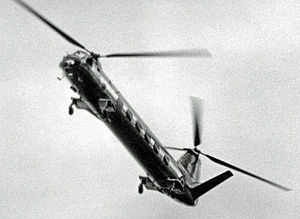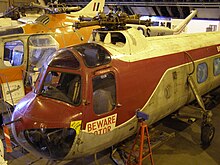Bristol Type 173
| Bristol Type 173 | |
|---|---|
 Bristol Type 173 |
|
| Type: | Transport helicopter |
| Design country: | |
| Manufacturer: | |
| First flight: |
January 3, 1952 |
| Number of pieces: |
5 |
The Bristol Type 173 is a British twin-engine tandem rotor transport helicopter built by the Bristol Airplane Company . It was designed as a civilian transport helicopter, but the military also showed an interest in it. It did not go into series production, but was developed into the Bristol Belvedere , which was operated by the Royal Air Force from 1961 to 1969.
construction and development
The type 173 was a tandem rotor development of the earlier single-rotor helicopter Bristol Sycamore type 171. It received two double radial engines Alvis Leonides 755 and two main rotors on a new fuselage. The gears of both rotors are coupled to both motors via a common shaft, so that both rotors can be driven even if one motor fails. The first type 173 Mk 1 with the registration G-AIBN made its first hover on January 3, 1952. When landing after a second hover, there were ground resonance effects. Required changes to the machine delayed the first non-hover flight, which took place on August 24, 1952. In 1953 the Bristol Type 173 was tested by the Royal Air Force (using the registration number XF785) and test flights were also carried out on the aircraft carrier HMS Eagle for the Royal Navy . To overcome the resonance in the fuselage, the Type 173 Mk 1 was equipped with a four-bladed rotor. The second type 173 was designated as type 173 Mk 2 and received the military registration XH379. The Type 173 Mk 2 had a revised chassis with controllable front and rigid rear wheels. Small stub wings were mounted on the front and back to increase the cruising speed. These auxiliary wings were removed after a few flights. A version intended for the Navy was experimentally given an unarrowed horizontal stabilizer. As a result of studies by the Royal Navy, the latter showed interest in ordering the type for use on aircraft carriers. In August 1956, the second prototype was rented to British European Airways for evaluation . The Mk 2 was destroyed in an accident during an air show in Filton in September 1956. During the transition from cruise to hover, the helicopter fell nose first into the ground. The crew was unharmed. After the crash, the horizontal stabilizer was recovered from the Mk 2 and attached to the Mk 1 to study the best configuration for stability. The company received a contract from the Ministry of Supply for three test helicopters, these improved Type 173 Mk 3 had four-blade rotors, improved efficiency in gusty winds, a more powerful airframe and were powered by 850 hp Alvis-Leonides main engines. They were to be used for evaluation by the Royal Air Force and Royal Navy which has both issued specifications in 1953 for tandem helicopters. The Royal Navy tender (Specification HR.146) called for a helicopter powered by the Leonides Major for submarine, rescue and transport tasks. The HR.149 specification described a similar helicopter for the Royal Canadian Navy. The H.150 specification issued by the Royal Air Force called for a multipurpose transport helicopter with the ability to lift bulky external loads. Bristol produced three project models - Type 191 to meet Royal Navy requirements, Type 192 for the Royal Air Force and Type 193 for the Royal Canadian Navy. In April 1956, orders for 94 helicopters of all three types were placed. While the prototypes were still equipped with Leonides main engines, the Napier Gazelle shaft turbine was intended for series production. The third type 173 was first tested on November 9, 1956 in hover flight. Further flights were stopped after engine overheating and transmission failures occurred during tests on the floor frame. Although these problems were not serious, the Admiralty also used this as an argument to cancel the order from the British Navy and procured the Westland Wessex , a British variant of the Sikorsky S-58 . Soon after, Canada canceled the Type 193 order for economic reasons. The company relied on the Type 192 powered by the Gazelle engine for the Royal Air Force. The first two Type 191S helicopters were used as Gazelle ground test benches; the third helicopter used as a cell for fatigue testing of the structure. The original Royal Air Force order for 22 helicopters was increased to 26 units. The first Type 192 (later called the Bristol Belvedere ) flew on July 5, 1958.
variants
- Type 173 Mk 1
- First prototype.
- Type 173 Mk 2
- Second prototype.
- Type 173 Mk 3
- Three further prototypes for the military evaluation with four-blade rotors.
- Type 191
- Planned marine version. Never flown; the first two specimens were used as ground test cells for the Type 192 Gazelle engines.
- Type 192
- Military transport helicopter for the Royal Air Force named Belvedere.
- Type 193
- Variant of the Type 191 for the Royal Canadian Navy, was not built.
Users
- British European Airways for evaluation only
- Royal Air Force for evaluation only
- Royal Navy for evaluation only
Technical specifications
| Parameter | Data (Type 173 Mk 2) |
|---|---|
| crew | 2 |
| Passengers | 13 |
| length | 16.82 m (55 ft 2 in) |
| Main rotor diameter | 2 × 14.81 m (48 ft 7 in) |
| height | 4.57 m (15 ft 0 in) |
| Empty mass | 3547 kg (7,820 lbs) |
| Takeoff mass | 4990 kg (11,000 pounds) |
| drive | 2 × air-cooled 14-cylinder radial engines Leonides Major 755, each with 550 PS (405 kW) |
| Range | 298 km (185 miles) |
Preserved copy
The prototype Type 173 XF785 was on display at the Bristol Aero Collection in Kemble until the collection was closed in May 2012. Relocation to a hangar in Filton was expected in 2012. The helicopter was previously stored in the RAF Cosford Museum until 2002.
literature
- CH Barnes: Bristol Aircraft since 1910 , 3rd edition 1988, Putnam, ISBN 0-85177-823-2 .
- AJ Jackson: British Civil Aircraft Since 1919 Volume 1 , 1973, Putnam, ISBN 0-370-10006-9 .
Web links
Individual evidence
- ↑ Jackson 1973, pp. 260-263
- ↑ a b c d e f g h i j k l m n Barnes 1988, pp. 366-372
- ↑ Jackson 1973, p. 528
- ^ Bristol 173 Crash at Air Day . In: Aviation Archive . Retrieved September 6, 2011.
- ^ Bristol 192, Europe's Largest Military Helicopter . In: Flight International . 74, No. 2584, August 1, 1958, p. 170. Retrieved September 13, 2011.
- ^ Leonides Majors in Bristol 173. In: Flight 16 November 1956 p775
- ^ Bristol Aircraft since 1910
- ^ Bristol Type 173 Production List . In: Filton Flyer . Archived from the original on May 13, 2002. Retrieved September 6, 2011.
